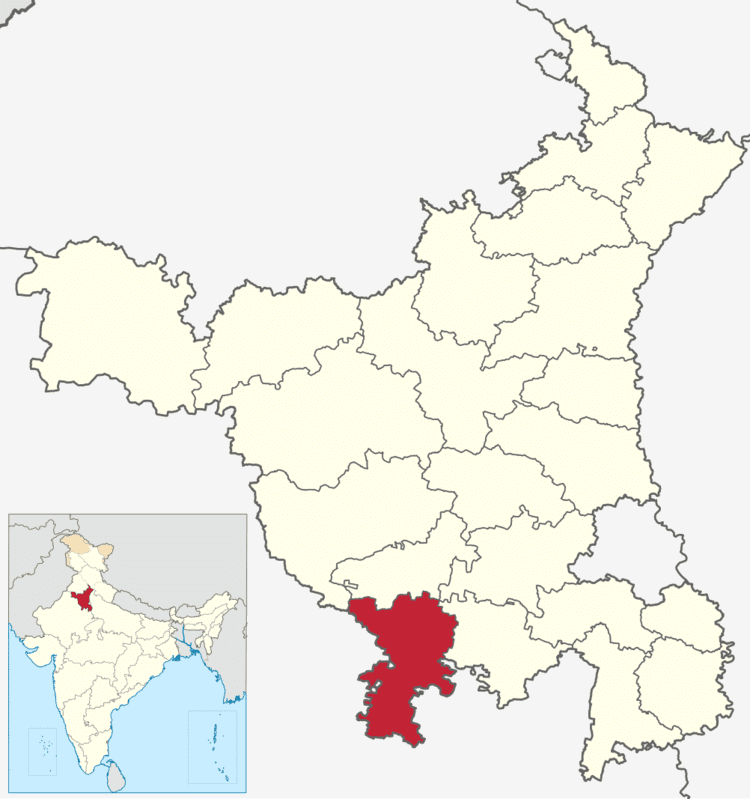Area 1,859 km² Local time Saturday 12:45 PM | State Haryana Website Official website Literacy 69.9% | |
 | ||
Weather 28°C, Wind S at 3 km/h, 27% Humidity University Central University of Haryana Points of interest Dhosi Hill, Chor Gumbad, Jal Mahal, Rao Tula Ram Chowk, Madhogarh Fort - Haryana | ||
Mahendragarh district (Hindi: महेन्द्रगढ जिला) is one of the 22 districts of Haryana state in northern India. The district occupies an area of 1,859 km². The district has a population of 812,022 (2001 census). Narnaul city is the administrative headquarters of the district. Mahendragarh is one of the very few districts in India where the name of the district and its main town are different.
Contents
- Map of Mahendragarh Haryana
- Origin of name
- Mahendragarh Fort
- History
- Geography
- Economy
- Tourism
- Divisions
- Demographics
- References
Map of Mahendragarh, Haryana
Mahendragarh is a part of the Ahirwal region in which members of the Yadav community dominate.
As of 2011 it is the third least populous district of Haryana (out of 21), after Panchkula and Rewari.
Origin of name
The district is named after Mahendragarh town, which was previously known as Kanaud. The previous name was derived from the Kanaudia group of Brahmins. It was founded by Malik Mahdud Khan, a servant of Babur.
Mahendragarh Fort
There is a fort at Mahendragarh which was built by Maratha ruler, Tantia Tope during the 19th century. This fort was named as Mahendragarh in 1861 by Narendra Singh, the ruler of Patiala, in honour of his son, Mahendra Singh and consequently the town came to be known as Mahendragarh. The name of Narnaul Nizamat was changed to "Mahendragarh Nizamat".
Other nearby fort is Madhogarh Fort on top of the hill near Madhogarh village.
History
Mahendragarh district was formed in 1948 by grouping different tracts of erstwhile princely states; Narnaul and Mahendragarh tehsils from Patiala State, Dadri (Charkhi Dadri) from Jind State and a part of Bawal nizamat from Nabha State. It became a part of Patiala and East Punjab States Union (PEPSU) state. On November 1, 1956, with the merger of PEPSU with Punjab, it became a part of Punjab state and with the formation of Haryana state in 1966, it became a part of the newly formed state. Rewari tehsil of Gurgaon district was added to it in 1972 but Rewari tehsil was made a separate district in 1989.
Geography
The district lies between north latitude 270 47 to 280 26 and east longitude 750 56’ to 760 51’. It is bounded on the north by Bhiwani and Rewari districts, on the east by Rewari district and Alwar district of Rajasthan, on the south by Alwar, Jaipur and Sikar districts of Rajasthan, and on the west by Sikar and Jhunjhunu districts of Rajasthan.
Economy
In 2006 the Ministry of Panchayati Raj named Mahendragarh one of the country's 250 most backward districts (out of a total of 640). It is one of the two districts in Haryana currently receiving funds from the Backward Regions Grant Fund Programme (BRGF).
Tourism
Dhosi Hill is an important tourist site in the District. Known as Chyawan Rishi Ashram it is a Vedic period site. It is here that Chyawanprash was formulated for the first time.
Divisions
Mahendragarh district is divided into 5 tehsils, Narnaul, Nangal Chowdhary,Kanina Mahendragarh,and Ateli . There are 4 Vidhan Sabha constituencies in this district: Ateli, Mahendragarh, Narnaul and Nangal Chaudhry. All of these are part of Bhiwani-Mahendragarh Lok Sabha constituency.
Demographics
According to the 2011 census Mahendragarh district has a population of 921,680, roughly equal to the nation of Fiji or the US state of Delaware. This gives it a ranking of 462nd in India (out of a total of 640). The district has a population density of 485 inhabitants per square kilometre (1,260/sq mi) . Its population growth rate over the decade 2001-2011 was 13.43%. Mahendragarh has a sex ratio of 778 females for every 1000 males, and a literacy rate of 78.9%.
